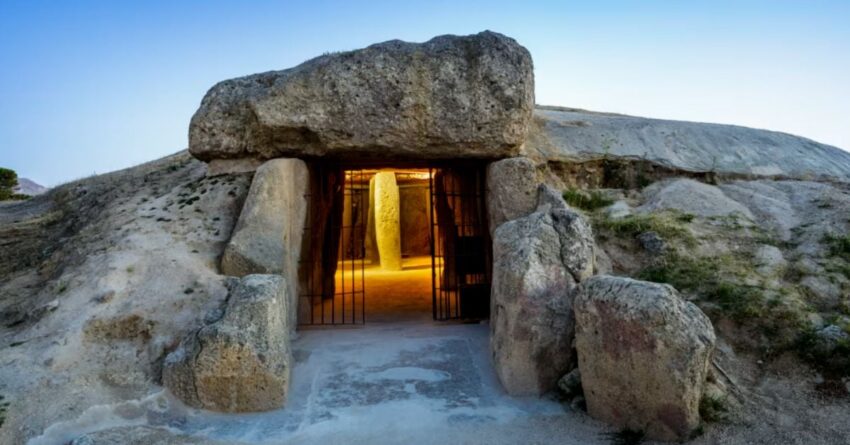In the heart of southern Spain lies the Menga Dolmen, a 5,600-year-old megalithic monument that poses an engineering enigma of monumental proportions. Comprising 32 colossal stones, this ancient structure dwarfs the largest megaliths at Stonehenge, solidifying its status as a significant Neolithic wonder. The recently published findings from a decade-long research project reveal not only the monumental scale of the dolmen but also the impressive technical prowess of its creators.
The Monument

Situated atop a hill that towers approximately 50 meters (165 feet) above the surrounding landscape, the dolmen stretches about 25 meters (82 feet) in length and 5 meters (16.4 feet) in width at its widest point. This colossal stone arrangement boasts a staggering collective weight of approximately 1,140 metric tons, equivalent to the weight of two fully loaded Boeing 747 airplanes. According to Leonardo García Sanjuán, a coauthor of the study and professor of prehistory at the University of Seville, the question of how this was constructed with Neolithic technology has intrigued researchers for decades: “I tell the students in my lectures … the weight is more than two Boeing 747 airplanes combined,” he said. “It’s a huge, enormous amount of stone, and it’s always been a mystery and an intriguing scientific question how on Earth (it was built given) the technology they had in the Neolithic period.”
How It Was Built

The research team, led by geologist José Antonio Lozano Rodríguez from the Canary Islands Oceanographic Center, meticulously pieced together the construction techniques used to erect the dolmen. By analyzing site topography, geology, prior excavations and historical construction accounts, they illuminated the sophisticated engineering skills that went into building this enduring monument. The dolmen’s upright stones form a trapezoidal chamber, with each stone leaning inward at a near-constant angle of 84 to 85 degrees. This remarkable precision suggests that builders employed tools such as plumb levels and framing squares. “The precision of the angles is millimetric,” said García Sanjuán. “They made a Tetris out of this, like the computer game.” The consequences of these techniques were a structurally sound edifice where each stone perfectly interlocked with its neighbors.
Survived for Centuries

Research findings also uncovered the unique method utilized to embed the upright stones. Initially, the stones were likely inserted into deep foundation sockets to securely anchor them in place, up to one-third of their height resting underground. Following the completion of the chamber walls, the builders placed five immense capstones to form the roof, subsequently excavating the earth to level the chamber floor. “The resulting building was then covered with a mound of soil, which would have insulated the chamber from cold and wet weather,” García Sanjuán noted, indicating the strategic design behind the monument’s longevity. This careful construction also served to stabilize the structure against seismic activity, a valid concern in the region.
The Monument’s Purpose

Despite the thorough research, the exact purpose of the Menga Dolmen remains somewhat elusive. While it likely served as both a temple and a tomb, the scarcity of archaeological remains complicates a complete understanding of its usage. The ongoing mystery adds to the monument’s allure and significance. “This linking of stone with the eternal is something which I think is a feature shared by all the prehistoric megalithic dolmens (and other tombs) of western Europe,” said Mike Parker-Pearson, a professor of British later prehistory at University College London, who commented on the research findings. He emphasized that the durability of structures like Menga reflects a quest for permanence. In a related study released in December 2023, the research team traced the dolmen’s massive stones to a quarry located approximately 850 meters (0.5 miles) away, perched 50 meters higher than the dolmen’s current elevation. The favorable slope likely facilitated the transport of these titanic stones. Garcia Sanjuán suggests that builders may have crafted a trackway to reduce friction during transport, using timber poles to facilitate movement.
The post Ancient Engineers Understood Science, Monument Proves appeared first on Knewz.
Click this link for the original source of this article.
Author: Joshua Wilburn
This content is courtesy of, and owned and copyrighted by, https://knewz.com and its author. This content is made available by use of the public RSS feed offered by the host site and is used for educational purposes only. If you are the author or represent the host site and would like this content removed now and in the future, please contact USSANews.com using the email address in the Contact page found in the website menu.







